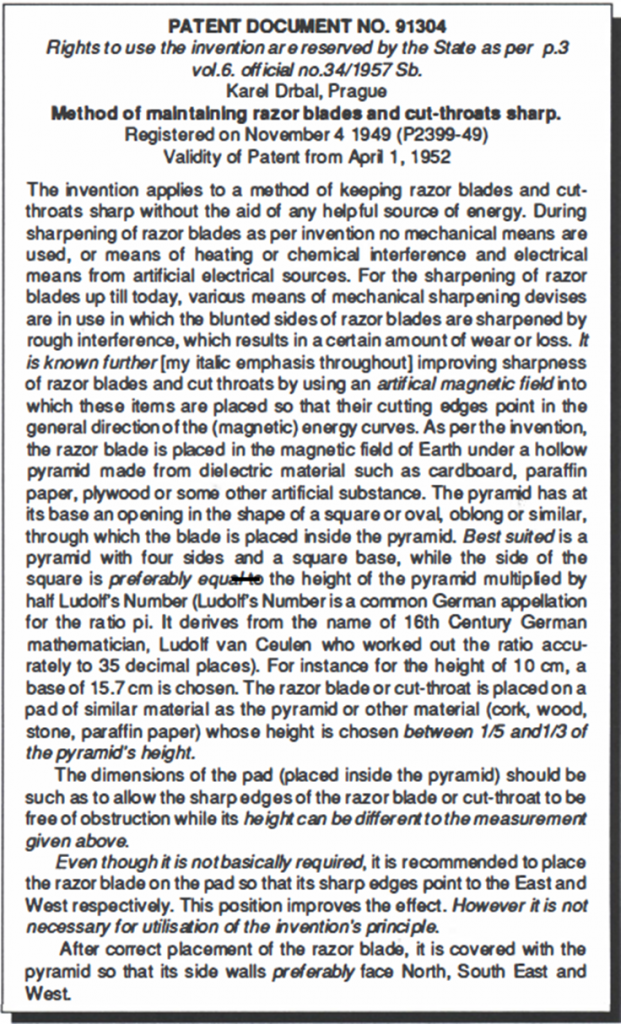This article originally appeared in The Skeptic, Volume 5, Issue 3, from 1991.
Clinging tenaciously to the myth of pyramid power, New Agers will expound at length on stories about the mysterious and miraculous properties that they ascribe to pyramids, erroneously supporting their beliefs with ‘authoritative’ quotations from ‘reliable’ researchers such as Erich von Daniken.
Occasionally, the name of a Czech electrical engineer, Karel Drbal, crops up as the man who not only allegedly discovered that a razor blade, placed under a pyramid-shaped container, will be re-sharpened by ‘magnetic energy curves’, but who actually patented a device which will harness the force to do just that. Further it is claimed that various foodstuffs, organisms, wine etc will remain fresh or preserved from decomposition by the properties inherent in the pyramid shape.

Drbal’s line of reasoning appears to have been motivated by the observations of a Frenchman by the name of Bovis, who had observed that the corpses of small animals in the Cheops pyramid in Egypt had been mummified. Although the interior of the Great Pyramid is humid, it is well known that the hot dry Egyptian climate and/or hot air currents are conducive to the rapid dehydration and preservation of corpses in a mummified form. Since time immemorial in the Far East, fish have been laid out in the hot sun to dehydrate and preserve them and, once dried, they will keep almost indefinitely. Drbal decided, however, that there was a more mysterious force at work and the multi-purpose, multi-functional mini-pyramid was the result of his experiments.
Patenting an invention does not necessarily imply viability – plans for perpetual motion machines and rungless ladders for legless painters litter the archives of many a Patent Office. For reasons beyond the cognizance of even a moderately rational mind, Drbal’s idea caught on in the USA: the Toth Pyramid Company of New York was formed to manufacture and sell cardboard replicas. Since then the concept has proliferated in many forms, shapes, sizes and materials, from pyramid hats to aid meditation and temper psychic awareness, to pyramid-shaped dwellings for psychic and therapeutic benefit. It is doubtful, given the generally unquestioning and naive acceptance of the weird and wacky by your average New Ager, that any have ever bothered to enquire further. Had they done so, those, who in a weak moment, may have succumbed to critically examining the evidence would have had their faith shattered, for not only is the description of the invention completely devoid of any supporting scientific evidence, but the inventor actually negates his own hypothesis.
Below is a facsimile of page one of the patent and a marginally abridged translation. Reading it, I find it difficult to believe that the inventor, whose exposition appears to be inconsistent with the attributes one would normally associate with his profession, is serious. This leads me to conclude that there must have been a devious motive behind the registration of such a patently transparent concept. Either there was a sinister communist plot to undermine the production of razor blades by private enterprise, or this was a ploy to help the Czech steel industry to meet its quota. Coincidentally, the patent became valid on April 1.

By using the invention, 16 razor blades, Czech Trade Mark ‘Dukat Zlato’ completed 1778 shaves, giving an average of 111 shaves per blade. The lowest number was 51 and the highest 200. From the national economy point of view the advantages are as follows: one razor blade of the above trade mark weighs 0.51g. We will consider as average 50 shaves when the blade is sharpened in the pyramid against 5 shaves without the aid of the pyramid. Thus in one year we use 73 blades, without using the pyramid, against 8 blades with pyramid sharpening – a saving of 65 blades annually, or 33.15g of stainless steel.
For the registration of the invention, only the pyramid shape has been tested but the invention is not restricted to this particular shape. It may consist of another geometrical shape made from dielectric materials and used in the same method. Consider the following references to dielectric materials, artificial magnetic fields, alignment, geometric shape and the mathematics and geometry in Mr Drbal ‘s description of his invention.
Dielectric materials
I can claim a rudimentary knowledge of electrical components gleaned from an apprenticeship in the era immediately following the invention of the germanium crystal and cat’s whisker detector set (those readers under the age of 60 not familiar with the terms should consult The Early Days of Wireless by Mark Oney) and seem to recall that dielectric material is simply another name for insulation such as paraffin wax paper, mica, glass and even air found between the plates or aluminium foil of a condenser or a capacitor.
It can be stated unequivocally that to function, a condenser requires the application of an electrical potential and its dielectric is not affected by or has anything to do with magnetism, which works on stationary ferrous metals and moving things such as electric motors and generators. Drbal’s dielectric serves no purpose other than to keep the dust off its contents. Paradoxically, if magnetism was not subject to Kepler’s inverse proportional law, then an increase in the dielectric constant (air plus an additional insulation) would inhibit not enhance the effects of magnetic flux.
Artificial magnetic fields
Although Drbal omits any reference when he claims that ‘it is known further that razor blades can be sharpened by artificial magnetic fields’, this unsubstantiated claim implies that a razor blade placed in proximity to a refrigerator motor or between the poles of a horseshoe magnet would be just as efficacious as his pyramid.
Alignment
The earth’s relatively weak magnetic field notwithstanding, the inventor invalidates the requirements of N-S-E-W alignment by saying that while it is preferable it is ‘not necessary’. And later, although he recommends a certain alignment of the razor blade, he abrogates the requirements by adding that ‘it is not basically required’!
Geometric shape
This is where any credence, if any can be had at all in the putative powers of a pyramid shape, evaporates. Drbal states ‘It [the container] may consist of another geometrical shape’ and, using another shape ‘regeneration of the razor blade will take place too’. This statement negates completely any suggestion that the uniqueness of a pyramid shape enhances in some way the focus or concentration of the Earth’s magnetic field.
Mathematics
A complete absence of mathematical and geometrical precision is evident in the physical construction requirements where Drbal says ‘the sides of the pyramid should preferably be equal to the height multiplied by Ludolf’s number’ and whose ‘height should be between 1/5 and 1/3 of the pyramid’s height’, and finally its height can be different’.
Conclusion
Drbal would have us believe that a razor blade can be placed at any height, facing any direction and under any non-metallic container regardless of shape or size and a mysterious honing energy will act upon it. In view of the contradictions, ambiguity, arbitrariness and assumptions replete throughout Drbal’s description, it is difficult to isolate any resemblance to a coherent and plausible hypothesis. Given the unrestricted parameters, it vaguely implies that a pyramid shaped container somehow focuses geomagnetic fields to interact with the atomic structure of metals. While this would have immense industrial and scientific value, a consideration of the materials and methods used place it in fairyland.
Acknowledgements
My thanks to Pani Helena Simlova, of Prague, who went to a great deal of trouble to obtain a copy of the patent, and to her brother Josef Holman for his translation.



